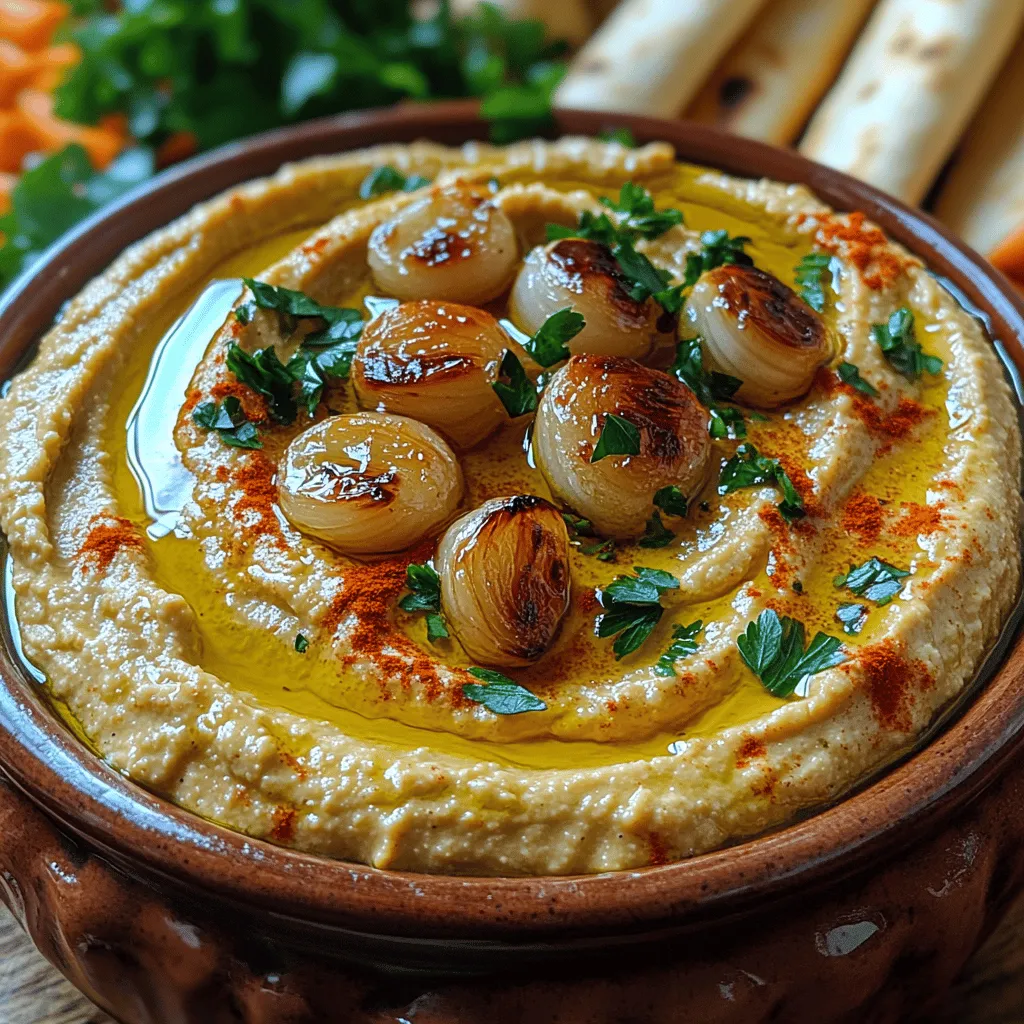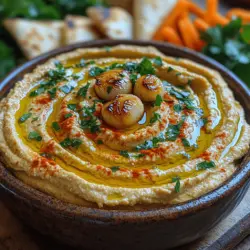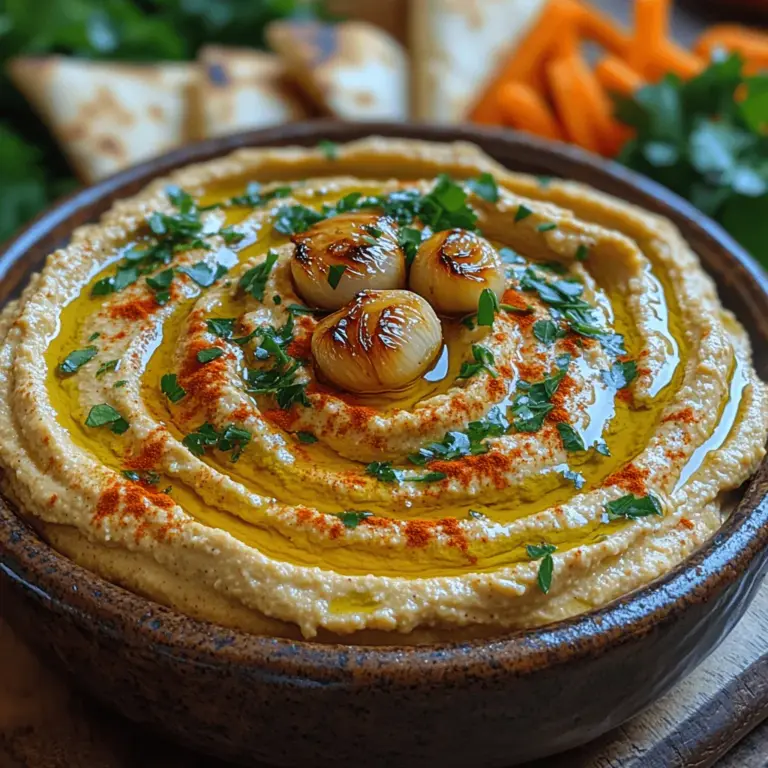Introduction
Hummus has transcended its Middle Eastern origins to become a beloved staple in kitchens and restaurants around the globe. This creamy roasted garlic hummus recipe not only showcases the rich, savory flavors of roasted garlic but also offers a nutritious dip that pairs perfectly with a variety of dishes. Whether you’re hosting a gathering, enjoying a quiet evening at home, or simply looking for a healthy snack, this hummus is the perfect choice.
In this hummus, the key ingredients come together to create a blend of creamy texture and bold flavors. Roasted garlic adds a sweet and nutty depth, while tahini—a paste made from sesame seeds—provides a rich, buttery undertone. The use of fresh lemon juice brightens the overall profile, balancing the richness of the tahini and garlic. Olive oil rounds off the flavors, adding a silky finish that enhances the overall experience.
This recipe is not just about taste; it’s also about health. Packed with plant-based protein, fiber, and healthy fats, this hummus serves as a nutritious alternative to heavy dips. Each ingredient has its own unique benefits, making this dish not only delicious but also a wholesome addition to your diet.
Understanding the Ingredients
To create the most flavorful and nutritious creamy roasted garlic hummus, it is essential to understand the primary ingredients and their benefits.
Fresh Produce: Vegetables and Herbs
The foundation of any great hummus is its fresh produce. For this recipe, the star ingredient is roasted garlic. Roasting garlic sweetens its flavor and mellows its pungency, resulting in a smooth, buttery addition to the hummus. Fresh herbs like parsley can also be added for a pop of color and freshness, enhancing the overall taste.
Proteins: Plant-Based Options
Hummus is primarily made from chickpeas, a fantastic source of plant-based protein. Chickpeas, also known as garbanzo beans, are rich in fiber, which aids digestion and helps you feel fuller longer. They also provide essential vitamins and minerals, including iron, magnesium, and folate. For those looking to boost the protein content even further, additional protein sources like hemp seeds or nutritional yeast can be incorporated, enhancing the nutritional value without compromising flavor.
Importance of Ingredient Quality
The quality of the ingredients you use can significantly impact the final taste and texture of your hummus. Opting for high-quality, organic chickpeas can lead to a creamier consistency and a more vibrant flavor. When it comes to tahini, look for brands that use only sesame seeds and minimal additives; this ensures a pure taste that shines through in your hummus. Freshly squeezed lemon juice is also crucial; it provides a bright acidity that cuts through the richness of the tahini and garlic, balancing the flavors beautifully.
Sourcing Fresh Produce
For the best results, consider sourcing your ingredients locally. Farmers’ markets often offer fresh produce at peak quality—an excellent way to support local agriculture while ensuring your hummus is made with the freshest ingredients. When selecting garlic, look for bulbs that are firm and plump, avoiding any that are soft or sprouting. Similarly, choose chickpeas that are free from blemishes and have a uniform color.
Selecting the Right Grains
While traditional hummus primarily focuses on chickpeas, pairing it with whole grains can create a satisfying meal. Options like whole grain pita bread, quinoa, or brown rice provide additional fiber and nutrients. Whole grains can help enhance the texture of your meal, offering a hearty complement to the creamy hummus.
Preparation Techniques
Successfully preparing this creamy roasted garlic hummus requires some essential techniques and tools.
Chopping and Slicing Techniques for Vegetables
When it comes to preparing garlic for roasting, the technique is straightforward. Begin by removing the outer layers of the garlic bulb, leaving the individual cloves intact. Cut the top off the bulb to expose the cloves slightly, which allows them to roast evenly. Drizzle with olive oil and wrap in foil for roasting.
For herbs, it’s important to chop them finely to release their essential oils and flavors. Use a sharp knife and a cutting board to mince fresh parsley or any other herbs you might want to include in your hummus. A rough chop will work if you prefer a more rustic texture.
Marinating Ingredients
While marinating is not typically necessary for the chickpeas used in hummus, adding flavors to your garlic before roasting can enhance the dish. Consider drizzling the exposed garlic with olive oil and sprinkling with a pinch of salt to infuse it with flavor during the roasting process.
Cooking Grains to Perfection
If you choose to serve your hummus with a grain, ensure you follow proper cooking techniques. Rinse quinoa or brown rice thoroughly before cooking to remove any bitterness. Follow the recommended water-to-grain ratios, bringing the water to a boil before reducing to a simmer until the grains are tender and fluffy.
Kitchen Tools and Equipment
Having the right kitchen tools can make a significant difference in preparing your hummus. A high-quality food processor is essential for achieving that smooth, creamy consistency. A good knife and cutting board are also necessary for prepping your ingredients.
Other helpful tools include measuring cups and spoons, a roasting pan for the garlic, and a spatula for scraping down the sides of the food processor during blending. If you plan to serve your hummus with fresh veggies or pita, consider investing in a good vegetable peeler and a sturdy serving bowl.
Importance of a Well-Equipped Kitchen
A well-equipped kitchen makes the cooking process more efficient and enjoyable. Having the proper utensils and appliances can streamline your preparation and ensure you achieve the best results. Investing in quality tools can also inspire confidence in your cooking, encouraging you to experiment with new recipes and techniques.
By understanding the ingredients, preparation techniques, and tools needed to make creamy roasted garlic hummus, you’re setting yourself up for success. The next section will provide a detailed, step-by-step guide to preparing this delectable dish, ensuring you can recreate it perfectly every time. Get ready to enjoy a delicious, healthy dip that is sure to impress!

Tips for Timing and Temperature Control
When making your creamy roasted garlic hummus, timing and temperature control are crucial to achieving a rich and balanced flavor. Roasting garlic might seem straightforward, but it requires attention to ensure it doesn’t burn and turn bitter. Here are some essential tips to help you perfect your hummus:
– Roasting Garlic: Preheat your oven to 400°F (200°C). Place the whole garlic bulb on a small piece of aluminum foil, drizzle with olive oil, and wrap it tightly. Roast for about 30-35 minutes or until the cloves are soft and golden brown. Keep a close eye on them after the 25-minute mark to prevent burning.
– Chickpea Preparation: If you’re using dried chickpeas, soak them overnight for at least 8 hours. This will reduce cooking time and improve texture. When boiling, aim for about 1-1.5 hours until they are tender. If using canned chickpeas, a quick rinse will suffice.
– Blending: After roasting, allow the garlic to cool slightly before squeezing the cloves from their skins. This will ensure you don’t burn your fingers and can mix them smoothly into the hummus. For the best texture, blend the ingredients in a food processor for at least 2-3 minutes until completely smooth, pausing to scrape down the sides as necessary.
Flavor Enhancements and Customizations
One of the fantastic aspects of hummus is its versatility. You can easily customize the flavor profile to suit your preferences or dietary needs. Here are some exciting variations and enhancements to consider:
– Exploring Variations: For a spicy kick, add some crushed red pepper flakes or a chopped jalapeño while blending. For a sweeter twist, consider mixing in roasted red peppers or even a tablespoon of honey or maple syrup.
– Alternative Ingredients: If you’d like to experiment with different legumes, white beans like cannellini or navy beans can be used instead of chickpeas. For those following a low-carb diet, cauliflower can be roasted and blended as a base for a low-carb hummus.
– Incorporating Seasonal Ingredients: Take advantage of seasonal produce by blending in ingredients like fresh herbs (such as basil or cilantro), sun-dried tomatoes in summer, or roasted butternut squash in fall. Seasonal cooking not only enhances flavor but also supports local agriculture.
– Benefits of Seasonal Cooking: Using seasonal ingredients ensures the freshest flavors and often provides better nutritional content. It also allows you to create a more sustainable kitchen by reducing the carbon footprint associated with transporting out-of-season produce.
Serving Suggestions
The presentation of your homemade hummus can elevate the dining experience. Here are some creative serving ideas to impress your guests:
– Plating Techniques: Serve the hummus in a shallow bowl, creating a small well in the center to drizzle with olive oil. Use a spoon or spatula to create artistic swirls in the hummus for a professional touch.
– Garnishes and Accompaniments: Top your hummus with toasted pine nuts, fresh parsley, or a sprinkle of smoked paprika to add texture and color. Consider serving it with an assortment of dippers such as pita bread, fresh vegetables like carrot sticks, cucumber slices, or even crispy breadsticks.
– Pairing with Beverages: When it comes to beverages, a crisp white wine such as Sauvignon Blanc pairs beautifully with hummus. If you prefer beer, a light lager or a wheat beer complements the flavors well. For non-alcoholic options, consider serving sparkling water with lemon or a refreshing herbal iced tea.
Nutrition and Health Benefits
Understanding the nutritional value of your creamy roasted garlic hummus can enhance your appreciation for this dish. Here’s a breakdown to consider:
– Nutritional Value per Serving: A typical serving of hummus (about 2 tablespoons) contains approximately 70 calories, 6 grams of fat, 4 grams of carbohydrates, and 2 grams of protein. The exact values may vary based on specific ingredients used.
– Health Benefits of Key Ingredients: Chickpeas are a great source of protein and fiber, which can help in maintaining a healthy digestive system. Garlic is known for its immune-boosting properties and heart health benefits, while tahini (sesame seed paste) provides healthy fats and essential vitamins.
– Dietary Considerations: This hummus is naturally gluten-free and vegan, making it suitable for various dietary needs. If you’re looking for low-carb options, you can substitute chickpeas with roasted cauliflower or zucchini.
Conclusion
In summary, the creamy roasted garlic hummus is not just a delicious dip; it is a celebration of flavors that can be easily tailored to your preferences. The art of cooking is about experimentation, and this recipe encourages you to get creative with flavors and ingredients.
By mastering the basics of timing, temperature control, and seasonal ingredients, you can create a hummus that is both nutritious and appealing. Remember, cooking is a joyful experience, and sharing meals with friends and family is one of the best ways to connect and create lasting memories. So, roll up your sleeves, gather your ingredients, and enjoy the process of making this delightful dish at home. Don’t hesitate to experiment with flavors and make this recipe your own – the possibilities are endless!

